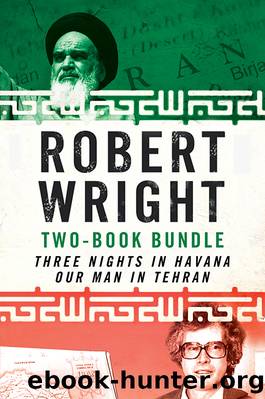Robert Wright Two-Book Bundle: Three Nights in Havana and Our Man in Tehran by Robert A. Wright

Author:Robert A. Wright [Wright, Robert A.]
Language: eng
Format: epub
Tags: Political Science, International Relations, General
ISBN: 9781443438773
Google: ZbGKBAAAQBAJ
Goodreads: 23016028
Publisher: HarperCollins
Published: 2014-09-16T00:00:00+00:00
The biggest riddle of the Iran hostage crisis is why U.S. president Jimmy Carterâthe man credited with putting human rights on the U.S. foreign-policy agendaâadopted his predecessorsâ policy of massive support for the shah and, in so doing, made himself an object of loathing for the Iranian people.
The answer to this riddle lay in Carterâs inheritance from Richard Nixon. In the wake of Vietnam, Nixon and Kissinger decreed a new strategic orientation for the United States, the Nixon Doctrine. The United States could no longer afford to pursue a policy of global anti-communism, they asserted, if this meant confronting insurgency in every corner of the world. Henceforth, the United States would pick its fights. It would disengage from the zero-sum game of containment unless its national interests were directly threatened. This new, downsized Cold War strategy was perfectly suited to the shah, whose aspirations to establish Iran as a regional superpower were limitless.37 But it was a disaster for the U.S. in Iran. âThe Nixon years crystallized the U.S. governmentâs relationship with the shah at the expense of the Iranian nation as a whole,â William Daugherty has explained. âFrom then until the end of Mohammad Reza Pahlaviâs rule, U.S. national security policies in the Middle East were predicated on him and his retention of power.â38
In May 1972, President Nixon visited the shah and agreed to an arms deal that would give Iran almost unlimited access to Americaâs non-nuclear arsenal. Over the protestations of the Pentagon, Nixon even promised the shah F-15 fighter jetsâplanes so new that they were not yet in use by the U.S. Air Force. As Jimmy Carterâs secretary of state Cyrus Vance later observed, nobody knew when this deal was inked that within a year the OPEC oil crisis would give the shah the money to commence âa military build-up of abnormal proportions.â39 By 1977, the shahâs generals had placed orders for an astounding $30 billion in new armaments from the United States, making Iran the Americansâ largest weapons export market by far. Ken Taylorâs friend Michael Shenstone visited Iran in February 1978 and could hardly believe what he saw. âI remember going out with Ken to Isfahan,â said Shenstone. âWe landed at Isfahan airport, and on the other side of the airport was a huge fieldâit looked like a square mileâof military helicopters that the shah had bought from the U.S. Helicopters as far as the eye could see. For what? You could see there the conspicuous waste. What was he defending himself against?â40
Many American policy-makers who later tried to figure out what went wrong in Iran highlighted the divergent views of Cyrus Vance and National Security Advisor Zbigniew Brzezinski, as though President Carter was incapable of reconciling their competing conceptions of Americaâs strategic interests. Carterâs DCI, Stansfield Turner, for example, believed that the âBrzezinskiâVance schismâ¦badly hurt the Presidentâs foreign policy.â41 Yet even at the worst moments of the hostage crisis the president never concurred in this view. âZbig is a little too competitive and incisive,â Carter confided to his diary in February 1979.
Download
This site does not store any files on its server. We only index and link to content provided by other sites. Please contact the content providers to delete copyright contents if any and email us, we'll remove relevant links or contents immediately.
| Arms Control | Diplomacy |
| Security | Trades & Tariffs |
| Treaties | African |
| Asian | Australian & Oceanian |
| Canadian | Caribbean & Latin American |
| European | Middle Eastern |
| Russian & Former Soviet Union |
The Secret History by Donna Tartt(18225)
The Social Justice Warrior Handbook by Lisa De Pasquale(11963)
Thirteen Reasons Why by Jay Asher(8472)
This Is How You Lose Her by Junot Diaz(6462)
Weapons of Math Destruction by Cathy O'Neil(5853)
Zero to One by Peter Thiel(5507)
Beartown by Fredrik Backman(5372)
The Myth of the Strong Leader by Archie Brown(5249)
The Fire Next Time by James Baldwin(5033)
How Democracies Die by Steven Levitsky & Daniel Ziblatt(4970)
Promise Me, Dad by Joe Biden(4916)
Stone's Rules by Roger Stone(4874)
100 Deadly Skills by Clint Emerson(4700)
A Higher Loyalty: Truth, Lies, and Leadership by James Comey(4565)
Rise and Kill First by Ronen Bergman(4553)
Secrecy World by Jake Bernstein(4406)
The David Icke Guide to the Global Conspiracy (and how to end it) by David Icke(4394)
The Farm by Tom Rob Smith(4332)
The Doomsday Machine by Daniel Ellsberg(4253)
